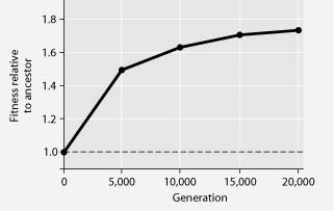The following question refers to the figure.
In this eight-year experiment, 12 populations of E. coli, each begun from a single cell, were grown in low-glucose conditions for 20,000 generations. Each culture was introduced to fresh growth medium every 24 hours. Occasionally, samples were removed from the populations, and their fitness in low-glucose conditions was tested against that of members sampled from the ancestral (common ancestor) E. coli population.
If the experimental population of E. coli lacks an F factor or F plasmid, and if bacteriophages are excluded from the bacterial cultures, then beneficial mutations might be transmitted horizontally to other E. coli cells via ________.
Definitions:
Alternation of Generations
A type of life cycle characteristic of plants and a few algae and fungi in which they spend part of their life in a multicellular n gametophyte stage and part in a multicellular 2n sporophyte stage.
Gametophyte
The reproductive stage in the life cycle of plants and algae where gametes, the cells responsible for reproduction, are created.
Sporophyte
The diploid multicellular stage in the life cycle of plants and algae that produces spores through meiotic division.
Diploid
Refers to cells that contain two complete sets of chromosomes, one from each parent.
Q9: How many distinct species, both living and
Q10: Currently, two of the living elephant species
Q11: Why might the cricket genome have eleven
Q17: Which species is most closely related to
Q32: The most important feature that permits a
Q34: In large scale, genome-wide association studies in
Q37: Which of the following steps has not
Q40: Which of the following processes helps bacterial
Q42: The following question refers to the following
Q42: Use the information to answer the following